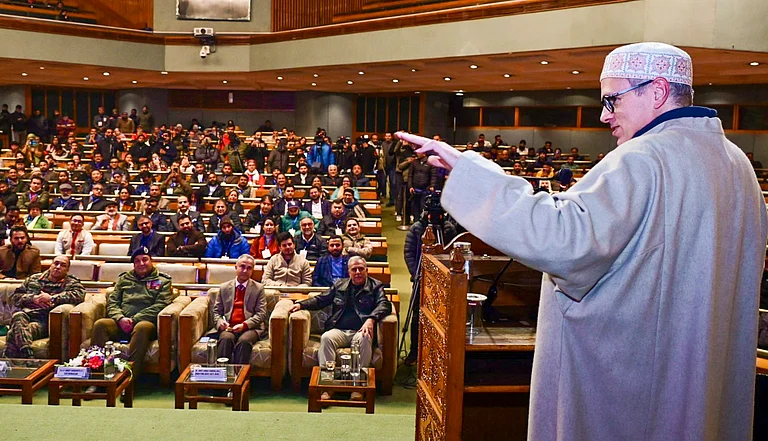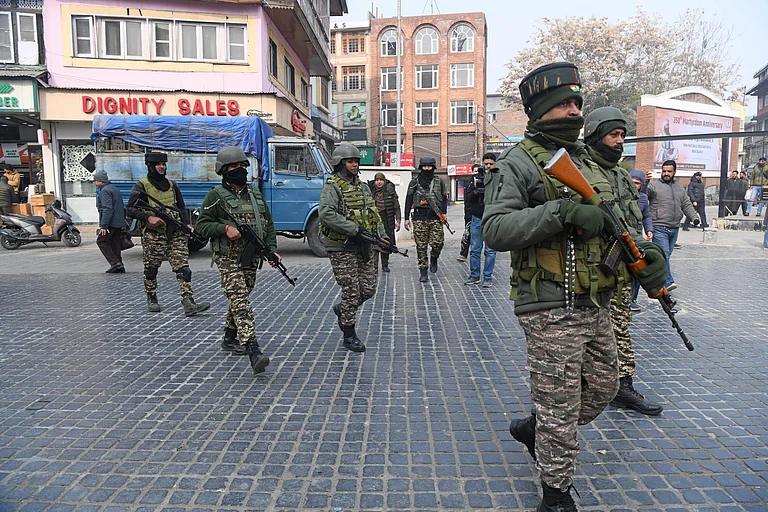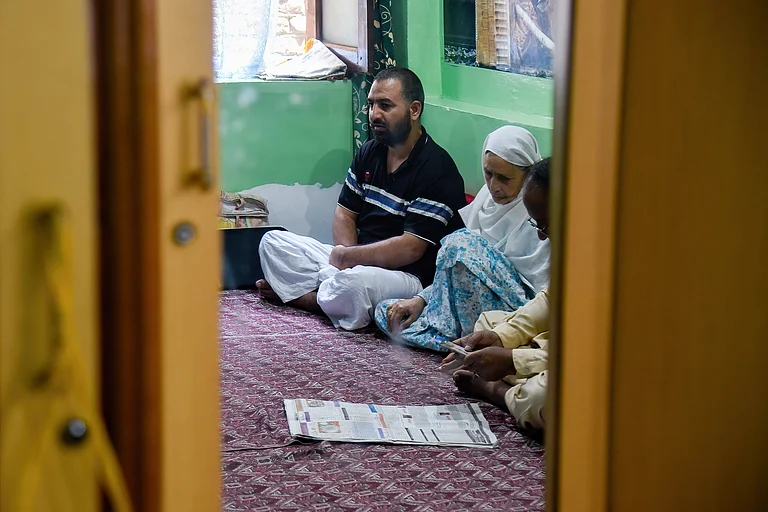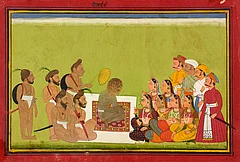A narrow lane in Kupwara’s Chogul village, barely wide enough for two people to pass, leads to the one-and-a-half-story house of mendicant Ghulam Rasool, popularly known as ‘Lasae bab’.
His door, as his followers say, is always open to everyone. This is his sister’s house, a typical Kashmiri brick-and-mortar affair. Children play on the big lawn out front. On the veranda, there is a hookah and two women, both wearing burqas with their faces uncovered, are waiting for him. They talk to each other as they wait for Lasae bab.
One of them had travelled all the way from Srinagar. “Bab is angry today and will not come out of his room. But I will wait and see if he comes out or I will have to come tomorrow, early in the morning. Without seeing his face, I cannot return home to Srinagar,” she says.
In Kashmiri culture, the terms peer and bab hold significant spiritual and cultural meanings. Peer is derived from Persian and is generally associated with a spiritual guide or saint. Bab is an affectionate term for an elder and in the context of spirituality; it refers to a holy person or a saintly figure.
Turning to the other visitors, the woman from Srinagar says, “If Lasae bab believes you deserve his attention, he will call you.” Her faith in Ghulam Rasool is unshakable.
At the entrance on the main road, everyone in Chogul seems to revere Ghulam Rasool. “His father was a farmer,” says a shopkeeper, who runs a business nearby. “He was the only son among four daughters. Bab completed his matriculation in the 1960s and then renounced everything. He went to the mountains for meditation and didn’t return for twelve years. When he came back, he was a changed man. He doesn’t take any money or ask for anything. He only responds to your queries if he wishes,” he adds.
Chogul in Kupwara, located around 80 km north of Srinagar, sits at an altitude of 5,300 feet in the Pir Panjal mountain ranges. These mountains, with their meadows and pastures, provide grazing grounds for cattle and sheep. The villagers are mainly paddy farmers and orchardists. According to a local legend, it was in these mountains that Lasae bab spent 12 years in solitude, deepening the mystique of his story.
Chogul is also known for its cheese throughout Kashmir. Most of the shopkeepers in the village sell or make cheese for a livelihood. Some even claim to export the locally produced cheese. One of the shopkeepers, sporting a long beard, has a take on the modern-day saint. “Lasae bab did his matriculation way back in the 70s (a relatively significant educational qualification in that era). Had he not renounced worldly things, he would have joined the government service and retired as a senior officer.”
But on April 16 this year, when a 72-year-old woman, a follower of the Sufi, arrived at Ghulam Rasool’s residence, she claimed, he attacked her with an axe in his room. An initial inquiry by the police corroborated her accusation.
The woman sustained severe head injuries and was rushed to the government medical college in Kupwara, where she succumbed to her injuries. Ghulam Rasool was subsequently arrested.
In Kashmiri society, almost everyone believes there is only a very thin line between mental breakdowns and spiritual breakthroughs.
According to a police official, the room in which Ghulam Rasool resides in his sister’s Chogul home, is shabby, cluttered with bundles of clothes and various types of axes scattered everywhere. There are also knives and sticks brought by his followers littered around. The official also said that Rasool has been known to beat his followers with these sticks and axes, something that they also acknowledge.
Over the years, he has consistently worn the pheran, a traditional long Kashmiri cloak, and maintained a long beard and hair, which appear to have skipped a trim and a haircut, respectively, for years.
Locals say his followers would give him iPhones, which he would smash on a whim. His followers also bring him doctors’ prescriptions and even injections, allowing him to administer them anywhere on their bodies without objection. Bab is also known for tearing currency notes offered by his followers into pieces.
Now, after his tryst with the police and prisons, Ghulam Rasool is back in his room in Chogul, as he awaits formal charges to be framed by the police. His believers, however, refuse to blame him for the crime he is being probed for. They dismiss the media coverage about the incident as unnecessary hype. On the contrary, they consider it a divine act.
“The peer gets angry, and we all know it. The woman insisted on seeing him when he was not keen to see her. He is guarded by unseen angels. He got angry and then attacked her with a stick. What else could he have done?” says one of the local shopkeepers, a disciple, who appears to be trying to downplay the incident, insisting that he lashed out at the victim with a stick, rather than an axe.
“Hundreds of people visit him, and he doesn’t ask anyone for anything. Everyone comes to him for something—whether it’s a childless couple, family disputes, terminal illness or depression. They believe he has shifa (healing power). I go to him myself,” he adds.
The shopkeeper says the peer would ask his followers for simple things: sometimes firecrackers, sometimes a stick and sometimes an axe. The followers would willingly bring these items, which he then kept in his room, a place where no one is allowed to enter. Some years ago, the Army got perturbed when they heard firecrackers being burst regularly, presuming it was gunfire, says the shopkeeper. Army personnel visited his home and when they saw him, they quietly left, he adds.
This is not the only bizarre story associated with Rasool.
“One of my friends went to Lasae bab early in the morning on July 16. Bab just put his hand in my friend’s pocket and pulled out Rs 30,000. He cut it all into pieces and my friend did not even regret it,” says a village, another cheese-seller.
In another account, a police official says that on April 16, when a team went to arrest him, bab got angry and even tried to beat them up. “While he was being held in custody, his devotees came in large numbers to meet him, bringing food and wanting to just catch a glimpse of his face,” the policeman claims. A senior official who tried to talk to him realised that he wasn’t coherent, responding only with a smattering few words, incoherently. As the incident caused outrage on social media, the Sufi was shifted to the Institute of Mental Health and Neurosciences, Kashmir, formerly called the Psychiatry Disease Hospital, Srinagar. A doctor at the hospital says he was surprised to see high-ranking people visiting Ghulam Rasool, prompting the hospital to house him in a separate room. He remained in the hospital for about 15 days. According to a senior police official, Rasool was released after the hospital’s medical board examined his case and declared him “schizophrenic and not mentally fit.”
A senior civil official was surprised by the popular reaction after Rasool was accused of attacking the woman with an axe. “I heard some people claim the woman who died because of him was actually lucky,” he added. Many scholars of Kashmiri Sufism believe there is a thin line between mental breakdowns and spiritual breakthroughs. They say that what constitutes one or the other often depends on culture and history. “For many people, there is not the irrational beyond the rational but the suprarational beyond the rational,” says a scholar who prefers to remain anonymous.
Kashmir has a long history of mendicants, revered for their perceived spiritual powers.
Arshad Hussain, Professor in the Department of Psychiatry at the Government Medical College Srinagar, took to social media to acknowledge the existence of spirituality and take a position in the context of the peculiar case of Rasool. He wrote, “It is sad when you live in a culture that cannot differentiate between schizophrenia and spirituality. Spirituality and violence are antonyms. Spirituality is not only peace within but also without. When you smell abuse of any kind—physical, verbal, emotional—you are not being healed but bruised.”
Kashmir has a long history of mendicants, revered for their perceived spiritual powers and eccentric behaviour. These individuals are popularly believed to be in constant communion with the divine, leading to actions and a set of behaviours that may seem irrational to the rational person.
Many of these schizophrenics often tend to roam the streets in tattered clothes, living off the charity of others. Despite their erratic behaviour, they are perceived as vessels of divine will, and their actions are often interpreted as having deeper spiritual meanings. However, there seems to be a difference in the manner in which a schizophrenic peer and an ordinary schizophrenic are dealt with by the administration in Kashmir. Many schizophrenics accused of crimes like murder, languish in the Psychiatry Disease Hospital in Srinagar for decades, despite the hospital informing the courts that they are not mentally stable. The courts, however, have not granted them any relief. The case of Ghulam Rasool seems to be ‘special’ because he is considered a peer.
Musadiq Bashir, a 20-year-old engineering student from Pulwama in South Kashmir, has been familiar with the sight of aimless schizophrenic wanderers all his life. Last year, he took it upon himself to care for them by bathing them, cutting their hair, shaving them and helping them appear more like regular people. Initially, he focused on schizophrenics who weren’t local residents, having been warned not to interfere with the local ones due to their perceived spiritual powers. Despite these warnings, Musadiq and his friends ultimately chose to extend their help to the local wanderers as well.
Recently, they received a call from Nawakdal in the old city of Srinagar. A family requested that they bathe a relative who hadn’t had a bath in years. When they started cutting his hair, he shouted in English, “I have no interest in the world. Leave me alone.” They later learned that he had lost around Rs 30 lakh in the pashmina business about 25 years ago, which caused his mental breakdown. After grooming him, the man looked young and fresh.
Arshad Hussain says, “Ninety per cent will be able to live productively in their homes if their illness is detected early and treated. Some will require institutional care, so we need institutions of care—hospitals, halfway houses—to prevent homelessness. All institutional care with the least restrictive options was applied.” He narrates the story of a patient who, in his early 20s, began living aloof and unkempt. He would talk to himself and wander, eventually living outside his house in a small polythene covered shed. His family initially tried to bring him back home, but he resisted violently. Now in his late 30s, they had left him to his fate. When the family eventually sought a medical opinion, a doctor concluded that schizophrenia was a probable diagnosis, but added that he would need an in-person consultation. He discussed treatment options with the family and explained all the pharmacological choices, including olanzapine, which had recently been introduced in India.
“After around six months, the family returned, anxious but smiling. They told me their uncle had returned completely to his senses. The whole neighbourhood is saying a miracle happened, but only we know that we are giving him olanzapine surreptitiously,” Arshad says.
But the larger question is for how long, youngsters like Musadiq Bashir will continue their diligent, but sporadic efforts to spruce up the appearances and in a way, the lives of ‘non-peer schizophrenics’ roaming the streets of Kashmir. “Many praise us, but others warn us that we are meddling in spiritual territory. However, we believe these people need proper care and treatment, especially by doctors, and a separate house for their well-being,” says Bashir.
MORE FROM THIS ISSUE
In Kashmiri society, where almost everyone is of the belief that there is only a very thin line between mental breakdowns and spiritual breakthroughs, the path Musadiq and others like him, have ventured on, seems like a tough one.











.jpg?auto=format%2Ccompress&fit=max&format=webp&w=768&dpr=1.0)






















